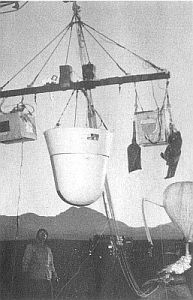Purpose of the flight and payload description
The objective of the flight was to perform a drop test from the stratosphere of a DISCOVERER satellite nosecone.
Context
At the start of the space race, the soviets had already beaten the US into space with the launch of the sputnik I on october 4 1957. The next achievement in the quest for space superiority was the physical recovery of a payload that had been in orbit. The Discoverer satellite -the sensor to be used in the spy program CORONA- was to be propelled into orbit and then eject a capsule containing an american flag to enable the US to claim this honor and more important to test the feasability of the method to recover photos obtained by CORONA.
During 1959 and 1960 the Discoverer program performed 10 attempts to recover a capsule from orbit, all unsuccesfull. Looking for a way to overcome the failures it was decided to test the faulty components by dropping a Discoverer nosecone from a stratospheric balloon over New Mexico. The launch of the 11th mission from Vandenberg AFB in April 1960 was put into a hold pending results of the drop test series.
Details of the balloon flight
Balloon launched on: 4/5/1960
Launch site: Holloman Air Force Base, Alamogordo, New Mexico, US
Balloon launched by: Balloon Branch, Holloman Air Force Base (HAFB)
Balloon manufacturer/size/composition: Zero Pressure Balloon General Mills 2.940.000 cuft (1.5 Mils. Taped)
Flight identification number: HAFB Nº 1118
End of flight (L for landing time, W for last contact, otherwise termination time): 4/5/1960
Landing site: In the White Sands Missile Range, New Mexico, US
Overall weight: 1924 lbs
The balloon was launched succesfully but the test became unsuccsesfull due to a parachute malfunction. Satellite firing at Vandenberg AFB was delayed awaiting results of the test
External references
- Balloon Branch Record U.S. National Archives
- The Roswell Report: Case Closed James McAndrews, Headquarters United States Air Force, 1997 pag. 156 - 158
910If you consider this website interesting or useful, you can help me to keep it up and running with a small donation to cover the operational costs. Just the equivalent of the price of a cup of coffee helps a lot.


